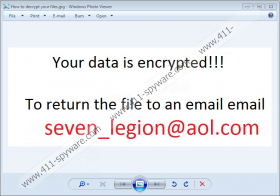Seven_legion@aol.com Ransomware Removal Guide
Did you let Seven_legion@aol.com Ransomware in by opening a corrupted spam email attachment? Is the infiltration of this ransomware a complete mystery to you? Whatever the case is, this infection is extremely dangerous, and, if it has successfully initiated its attack, your personal files must be corrupted. Not only that, this infection can encrypt the files of regular applications as well. Obviously, it does not target system files to avoid compromising your entire operating system, but it can corrupt your browsers and other downloaded applications. Unfortunately, once the files are encrypted, you do not have many options. In fact, if you want to decrypt the files, you will have to follow the instructions provided by cyber criminals, and that, of course, is extremely dangerous. Even if you have already done everything that you were told to do, you must not forget to delete Seven_legion@aol.com Ransomware, and this is what we focus on in this report.
The RSA-2048 encryption key is used by Seven_legion@aol.com Ransomware for the encryption of your files. This encryption method is also employed by Batman_good@aol.com Ransomware, Melme@india.com Ransomware, and hundreds of other ransomware infections. All of them were created using the CrySIS Ransomware engine, which is exactly why they are considered identical. Sure, the names of these threats are different, the information that is represented via the created .txt and .jpg files is unique in every case, and the email addresses are different as well, but that is because multiple malware creators are responsible for these infections. For example, in the case of Seven_legion@aol.com Ransomware, it is possible that its creator does not speak English very well. We assume this because of the messages that are represented via "How to decrypt your files.jpg" and "How to decrypt your files.txt" files. The purpose of these messages, however, is clear, and cyber criminals want you to email them at seven_legion@aol.com. Obviously, if you establish communication, the creator of this ransomware will push you to pay a ransom.
A ransom is a fee that cyber criminals expect from you in return of a decryptor, but because they are not trustworthy, their actions are unpredictable. Clearly, all they want is your money, and who’s to say that they will care about the decryption of your personal files once you give them what they want. Therefore, before you choose to pay the ransom, you should consider a few things. Are the files encrypted by this monstrous infection truly valuable? These files have the ".id-[your ID].Seven_legion@aol.com.xtbl" extension added to them (e.g., photo.jpg.id-[A0123456].Seven_legion@aol.com.xtbl), and so it will not be hard for you to identify them. If you find out that the files encrypted by the ransomware are truly valuable, think if maybe you have them backed up, for example, in an external drive. If you do, remove Seven_legion@aol.com Ransomware without further delay. Another thing to consider is using legitimate third-party decryption software. Although software that is capable of deciphering the keys used by this ransomware does not exist yet, it might have been created by the time you are reading this. Overall, we do not recommend paying the ransom, even if that is your last and only option.
If you are interested in removing Seven_legion@aol.com Ransomware manually, you need to know a few things. First, you need to know how to edit data in the Registry Editor. If you are not familiar with this process, you might have trouble eliminating the threat. The removal of this malware is complicated due to its nature. The name of the main file and its location are unknown, and we cannot guarantee that you will find and get rid of it using our guide. Hopefully, you do. Otherwise, do not push back against automated malware detection and removal software. This software is truly irreplaceable as it can erase even the most hidden malware elements, and it can help you keep your operating system protected against malware in the future. Do not hesitate to start a conversation about the ransomware and its elimination in the comments section below.
How to delete Seven_legion@aol.com Ransomware
- Launch Explorer by tapping Win+E keys.
- Visit the directories below (enter into the address bar) to find and Deletethe malicious executable:
- %WINDIR%\Syswow64\
- %WINDIR%\System32\
- %APPDATA%\Microsoft\Windows\Start Menu\Programs\Startup\
- %USERPROFILE%\Microsoft\Windows\Start Menu\Programs\Startup\
- %ALLUSERSPROFILE%\Start Menu\Programs\Startup\
- %ALLUSERSPROFILE%\Microsoft\Windows\Start Menu\Programs\Startup\
- %ALLUSERSPROFILE%\Application Data\Microsoft\Windows\Start Menu\Programs\Startup\
- Launch RUN by tapping Win+R keys and enter regedit.exe into the dialog box.
- Go to HKCU\SOFTWARE\Microsoft\Windows\CurrentVersion\Explorer\Wallpapers
- Open the BackgroundHistoryPath0 value and empty the value data.
- Go to HKCU\Control Panel\Desktop.
- Open the Wallpaper value and empty the value data.
- Go to HKLM\SOFTWARE\Microsoft\Windows\CurrentVersion\Run.
- Identify the malicious value (the value data should represent the executable), right-click it, and select Delete.
Seven_legion@aol.com Ransomware Screenshots:


